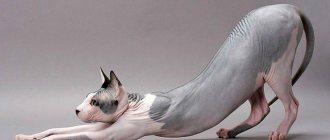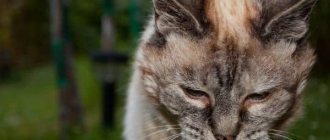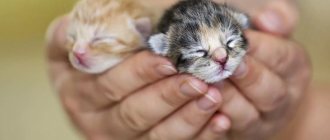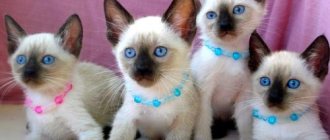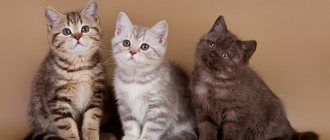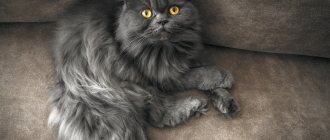Sphynxes are unusual cats that resemble aliens from another planet. Due to a genetic mutation and careful selection work, their body is completely or partially hairless. Because of this, representatives of the breed have a higher body temperature and require special conditions of detention.
Let's figure out how to care for the Sphynx in order to provide it with a comfortable and fulfilling life.
History of the Canadian Sphynx breed
Canadian Sphynx
Although the breed is quite young, the existence of hairless cats is mentioned in the annals of various civilizations. The thing is that “bald” offspring can appear from completely ordinary parents as a result of a natural mutation. Most often, such animals were considered an anomaly and were discarded by humans.
There is evidence of the emergence in South America of an entire population of graceful creatures with amber-colored eyes. True, unlike Canadians, they could be partially covered with wool during the cold season, and wore mustaches all year round. It is impossible to judge the genetic characteristics of these animals today, since the breed has disappeared. The last individuals whose existence is documented lived in the 20s of the last century, but then “Inca cats,” as the Mexicans called them, did not interest professional breeders.
40 years have passed, and much further north, in the Canadian province of Ontario, the owner of a black and white short-haired cat named Elizabeth was surprised to find an unusual specimen in her pet’s litter. The kitten was given the name Prune (English: Prune) and, upon reaching maturity, was crossed with its own mother. The first experiments seemed successful, but already in the early 1970s the line was interrupted.
Around the same time, a new stage in the history of the breed began. In one of the catteries in Baden, Minnesota, two cats were devoid of fur at once. All modern elite lines trace their pedigree back to them, although the selection process, of course, included cats of different breeds. The best results were achieved by working with Devon Rexes; “naked” kittens, which were again discovered among our northern neighbors, actively participated in the creation of the breed. They were originally called “Canadian hairless cats,” but enthusiasts wanted something more sonorous and drew parallels with the oldest surviving monumental sculpture - the Egyptian Great Sphinx, which guards the peace of ancient rulers in Giza.
Recognition from international felinological organizations did not come immediately. There were concerns that the mutation was causing serious health problems. When time showed the inconsistency of these theories, The International Cat Organization (TICA) was the first to allow Sphynx dogs to participate in its exhibitions in 1986. After 6 years, champion status was received from the Canadian Cat Association (CCA), but the breed standard according to the authoritative The Cat Fanciers' Association (CFA) was approved relatively recently, in 2002.
Is it possible to have different types at the same time?
When choosing food for a cat of this breed, you need to give preference to one type of food: either dry, wet, or natural. It is extremely undesirable to practice feeding two different species at the same time, since the Sphinx’s digestive system is not adapted to rapid adjustment.
Warning! If, nevertheless, the decision on a mixed diet is made, then “drying” is offered in the morning, and natural food in the evening. The order can be changed.
Also, you cannot mix “drying” from different manufacturers. Each manufacturer uses their own proportions and ingredients, and also gives specific recommendations on standards. When mixing granules of different compositions, there is no question of a balanced diet.
Stainless steel bowl
Appearance of the Sphinx
Sphynx kittens
Sphynxes are not large breeds. Females usually weigh 3.5-4 kg, males weigh between 5-7 kg. At the same time, the body is muscular and dense, which is why cats actually turn out to be heavier than one might expect given their size. The skin is thick and gathers into characteristic folds, especially pronounced on the muzzle.
Head
Medium in size, shaped like a slightly rounded modified wedge, where the length is slightly greater than the width. The forehead is flat, the transition from it to the muzzle can be either quite soft or clearly pronounced. The muzzle is short. The cheekbones are high and clearly defined. The chin is strong and forms a perpendicular to the upper lip. The nose is short, with a slight to medium stop. The whisker pads are well developed, although the whiskers themselves are completely or almost completely absent.
Ears
Ears are one of the distinctive features of the Canadian Sphynx breed. Very large compared to the head. Upright and open. The base is wide. The inner surface is without wool.
Eyes
The eyes of sphinxes are large, shaped like a lemon, because with a wide middle part they narrow equally on both sides. Set wide and slightly slanted. The color is not regulated, but must be in harmony with the color.
Neck
Medium length, slightly arched, with well-developed muscles.
Face of the Canadian Sphynx
Body
Sphynx paws
The body of the sphinx is of medium length, muscular. The chest is wide and rounded. The belly is round and full. The back of the body is rounded.
Legs
Medium length, proportional to the body. Strong and muscular. The hind ones are slightly longer than the front ones.
Paws
Oval, with thick pads and well-developed long toes.
Tail
White Sphynx
The length of the Sphynx's tail is proportional to its body. Graceful and flexible, gradually tapering from base to tip.
Cover and skin
The skin of the Canadian Sphynx is thick and forms folds, which are especially numerous on the face and legs. They seem completely hairless, but usually the body is covered with delicate down (a length of no more than 2 mm is allowed). The norm is the presence of short, sparse hair on the outside of the ears, tail, between the toes and in the scrotum area. The bridge of the nose is covered with the usual short hair for cats.
Color
Despite the lack of hair in the usual sense, sphinxes have many colors: white, black, red, chocolate, lilac (lavender), tabby, tortoiseshell, two-color, calico (tri-color), color point, mink. Neither conflicts with the CFA standard.
Is it possible to only wet food or only canned food?
The choice of type of cat food depends on the wishes and capabilities of the owners, so the pet can be fed either only wet food or only canned food.
Description of the Bengal cat breed, its character, behavior and color features
The only requirement is that you must choose products of at least premium class. In this case, both canned food and wet food contain all the substances necessary for the proper development of the pet.
Photo of the Canadian Sphynx
The character of the Canadian Sphynx
The ancient sculpture of a lion with a human head, lost in the African sands, was once called differently by Arabic speakers - Abu al-Haul, that is, the Father of Terror. But her little namesakes don’t seem at all intimidating to their owners. These are real “tails” that will follow a person everywhere and will not miss the opportunity to settle on his lap.
This sphinx has found its place
However, such affection is not at all an indicator of laziness. Sphinxes are very mischievous and playful creatures; they get involved in active fun with great excitement or independently come up with entertainment for themselves, such as “hunting” for a beetle that happens to be in the apartment. Games should be versatile and challenge not only dexterity and muscle strength, but also the intellect.
Sphinxes do not tolerate loneliness well, which should be taken into account by potential owners whose work involves frequent and long business trips. Canadians are attached not to a place, but to “their” people, so separation is a difficult test for them, even if in your absence the care of your pet is entrusted to reliable and kind hands.
Sphynxes are absolutely not aggressive, so they get along well with children of different ages and calmly share their home with other pets. Moreover, they know how to be friends with both cats and dogs, which helps brighten up the long hours of waiting to meet a person.
Representatives of this breed get used to being in large crowds of people quite easily. Thanks to this, sphinxes feel good at exhibitions, and some bring the skill of equanimity to such a level that they become real movie stars. The most striking example of this is Ted Nugent, who played the role of Mr. Bigglesworth, Dr. Evil's cat from the famous Austin Powers film series.
Hairless Canadian or Don kitten at 2 months
Sphynx kittens are adopted at approximately 2 months of age. Until this time, they are breastfed and receive their first complementary foods.
The owner needs to decide on the type of feeding - choose natural or wet food or dry food. If preference is given to the latter option, then special premium and higher class food is purchased, intended specifically for kittens. Before giving, the granules must be softened in advance with water.
Many premium manufacturers offer wet food. The feeding rate is indicated on the packaging.
But for the first days after the move, the kitten continues to be fed what it received at the breeder’s house. A change of place of residence and the absence of a mother is extremely stressful for a pet, and a change in its usual diet will only increase it. New nutrition is introduced gradually. The intestines will be completely rebuilt within a week, and will absorb food that is unusual for it in full.
If the new owner does not know what the kitten was fed by the breeder, then you can follow the standard recommendations. The menu should include:
- ground veal – boiled or well frozen and scalded;
- cottage cheese;
- egg yolk;
- a mixture of meat and vegetables in the form of a pate.
At 2 months of age, a kitten should eat up to 6-8 times a day, in small portions. Therefore, you will have to feed him at night, if necessary. This regimen must be maintained until 4 months of age.
Ragdoll cat breed, description of colors and photos, as well as their character, standards and sizes
The average volume of one serving for a 2-month-old Sphinx is 25 g. It can be increased or decreased. The owner makes adjustments independently, focusing on the physical condition and activity of the kitten.
At the age of 2 - 3 months, calcined cottage cheese, vegetables, spinach, unsalted cheese and sour milk are gradually added to the menu.
Advice! It is advisable to give fermented milk as an independent dish, for example, during an afternoon snack.
And the Canadian Sphynx, and the Don, and the Dwelf, and the Cohons, and the Minskin, and the Bambino, and the Ukrainian Levkoy, and the Elf have a sensitive stomach, so all uneaten food should be thrown away immediately so that it does not become a source for the growth of bacteria and the cause of food poisoning.
Clean water, which must be renewed at least once a day, should always be freely available. Otherwise, the kitten may experience constipation and develop dehydration.
Care and maintenance
Having no hair may seem like a big advantage to a busy owner, but in fact, Sphynx cats require even more care than their furry counterparts. The sweat and sebaceous glands in these cats work in “normal mode”, so a kind of plaque forms on the surface of the skin, which provokes the appearance of greasy stains on the owners’ clothes, bedding and upholstery.
Canadian Sphynx in a sweater
To avoid this, hygiene procedures should be carried out regularly. Some people think that it is enough to wipe the cat’s body with wet wipes that do not contain alcohol or fragrances. But most agree that the optimal solution to the problem is weekly bathing with special mild products or baby shampoo. If you accustom a kitten to them from an early age, the process will happen quickly and without much hassle. Please note that immediately after a bath the sphinx must be wrapped in a towel!
The issue of hypothermia is generally quite acute for representatives of this breed. When you hold a hairless cat in your arms, it seems really hot. The fact is that due to the lack of a fur “buffer”, heat exchange with the external environment is much more active in them than in other animals. This means that in a cool room the sphinx will freeze no less than a naked person, so buying special clothes for winter and the off-season will not be superfluous even for permanent residents of city apartments.
By the way, experienced breeders recommend exclusively keeping Canadian Sphynxes at home. If you consider it necessary for your pet to stay in the fresh air, it is better to limit its duration and monitor the cat at all times. Independent walks are contraindicated not only because of the risk of colds or sunburn (yes, Sphynx cats can get tanned and burn, so in the summer they need sunscreen!). Thanks to its characteristic appearance, even a layman can easily recognize your pet as a purebred, which means a potentially expensive animal, which can lead to kidnapping.
We didn't find a house and organized it ourselves
Other care tips differ little from the standard ones. It is important to monitor the condition of the eyes and ears to avoid infections. Regular brushing of your teeth with a special paste guarantees protection from tartar, and trimming your nails will help keep your furniture and walls in their original condition.
The cat will be grateful for a personal “house” with the opportunity to climb higher and play hide and seek, but most sphinxes prefer the owner’s bed, where you can comfortably sit under a warm blanket, to a soft bed.
All sphinxes have an excellent appetite. This is another side effect of not having fur, as they require more energy than other cats due to their intense heat exchange. The main thing is that the quality of the food is at a high level and fully satisfies your pet’s needs for proteins, fats, carbohydrates, vitamins and minerals. The easiest way to achieve this balance is with specialized premium and super premium food. But if you are willing to spend time creating a healthy menu of foods, natural nutrition will be a worthy alternative.
Leftovers are sweet
Canadian Sphynx having a meal
Vaccination
Sphynxes kept at home run the risk of becoming victims of viral and infectious diseases no less than their street counterparts. To protect cats of this breed from dangerous diseases, their care should include routine vaccination.
They are regularly vaccinated with a complex drug that stimulates the development of immunity to panleukopenia, calcivirosis and rhinotracheitis.
This is done for the first time when the kitten is 7-8 weeks old. After 4 weeks, the sphinx is revaccinated against the same diseases and against rabies. In the future, the cat is vaccinated annually, regardless of whether it is exclusively kept in an apartment or is on the street.
Important! Before vaccination, the animal must be subjected to antiparasitic treatment. Anthelmintic drugs are given to the cat 2 times with an interval of 10-14 days. The dose is calculated based on the pet's weight.
Health and illness of the Sphinx
Cute sphinx
In general, with the right diet and proper care, sphinxes are infrequent patients of veterinary clinics. Problems can be caused by hypothermia, prolonged exposure to the sun, neglect of hygiene rules on the part of the owners, and lack of immunity due to missed vaccinations.
But there are also breed-specific diseases. The weak point of Canadians is sensitive skin; it can be affected by urticaria pigmentosa. Redness and rashes on the body can also be symptoms of allergies, including food allergies. Only a doctor can determine the exact cause and prescribe treatment based on test results.
Like Maine Coons, Sphynx cats suffer from hypertrophic cardiomyopathy. This dangerous heart disease is caused by a genetic mutation, but to date there is no convincing evidence that heredity has a decisive influence on its development.
But another disease of sphinxes, myopathy, is transmitted to descendants from parents. They got it in the process of selective work with Devon Rex. Progressive muscle dysfunction has no cure, progresses individually and often leads to death as a result of laryngospasms. Usually appears at 4-7 weeks of age, but may be asymptomatic until 12-14 weeks. The nursery must warn you if the kitten is at risk.
The right diet
In order for the Sphynx to develop well and remain healthy longer, it is provided not only with proper maintenance and care, but also with balanced feeding. To remain active and maintain body temperature, hairless cats require more high-calorie food than representatives of shaggy breeds.
On a note. If the Sphynx's diet is low in fat, the animal will become cold and begin to overeat to make up for the lack of energy. And this is fraught with digestive problems.
With the industrial type of feeding, high-calorie products of premium or super-premium class are purchased for sphinxes. Before making a choice, you need to carefully study the description of the composition and make sure that it has sufficient fat content and there are no questionable components.
The following criteria are met:
- Royal Canin;
- Acana;
- Grandorf.
With a natural diet, the Sphinx's menu is designed so that it contains at least 70% meat. Also included in the diet of cats of hairless breeds is:
- boiled offal;
- porridge with water;
- vegetables;
- eggs;
- dairy products;
- lean sea fish.
It is important to ensure that cats of this breed never eat bones, baked goods, sweets, smoked meats, pickles and sausages. Also, sphinxes should not be given mushrooms, onions, river fish, fresh milk and any leftovers from the master's table.
How to choose a kitten
The main advice is the same for all purebred animals: do not try to save money on your purchase by going to the “bird market” or responding to a random ad. Only the best nurseries and breeders with an impeccable reputation will guarantee that you will receive a healthy pet, the origin of which cannot be doubted. After all, the Canadian Sphynx is not just a lack of hair, but a graceful, beautifully built, affectionate and intelligent creature that will live next to you for the next few years.
If you do not plan to participate in exhibitions, it is enough to make sure that the chosen baby is healthy and active, easily makes contact with people, without showing fear or aggression. The rest will be determined by the available documents (pedigree, veterinarian’s report, vaccination card). We recommend getting to know the parents and looking at the living conditions - they will say a lot about the breeder’s attitude towards the cats.
Elderly cats
Older Sphinxes play little and prefer to sleep most of the day. And if you don’t limit your daily caloric intake, your cat will begin to actively gain weight. For this reason, the volume of the usual portion is reduced by about 1/3, but this must be done gradually.
The cat's meals should be frequent and in small portions. The menu remains the same.
Elderly Sphynx cats need the following supplements to strengthen their immune defenses:
- vitamin C;
- fish oil – it contains Omega-3 fatty acids;
- vitamins of group A, B, E.
If a cat receives dry or commercial wet food, then it does not need to receive supplements.
Dry food - complete food
Photo of the Canadian Sphynx
How much does a Sphynx cost?
If you are offered to buy a Sphynx kitten for 3-4 thousand rubles, you can rest assured that there can be no talk of any pedigree here.
The price of kittens in trusted nurseries starts from 8-10 thousand rubles. Children who have more or less significant deviations from the breed standard are cheaper. They are perfect for those who dream of a pet with an extraordinary appearance and character.
Prospective exhibitors whose parents can boast of championship titles and other titles will cost their future owners at least 15 thousand rubles.
Sample menu by age
Up to a month
Sphynxes stay with their mother for a long time, suckling. However, if there is not enough milk, they resort to substitutes. The frequency of feeding up to a month should be every 2.5-3 hours. If the age is small, I resort to using special nipples.
The kitten will not overeat, but when looking for food it will worry and this indicates a small dose. You should start with 5-8 years. From 20 days of age, you can introduce liquid minced meat based on boiled fish or meat, fermented milk products, and chicken egg yolk into the diet. The norm is 6-7 g, frequency of 5-6 doses.
1 month
If the kitten is with its mother, great, but feeding should be done. Multiplicity 5-6 times a day. The norm is 7-10 g per dose.
In the diet:
- minced meat from boiled fish and meat;
- curdled milk;
- cottage cheese;
- eggs.
2 months
Feed intake can be limited to 5 feedings. The average one-time cumulative norm is up to 10 g. If the kitten is large and in constant search for food, you should increase the calorie content. You can add 5-6 g of sour cream per day to your diet.
Part of the meat can be replaced with minced meat from offal in the same quantity. The minced meat is dissolved with broth or kefir.
3 months
Feeding frequency is 4 times. The individual character traits of the kitten must be taken into account. If the feed is not enough, the energy value must be increased. From this age, fatty varieties of pork can be introduced into the diet in small quantities; in addition to boiled pork, it can also be fed raw.
A kitten can consume up to 15 g of food.
4 – 6 months
Feeding frequency 4 times a day. At one time, a kitten can eat 15-20 g of food, depending on the energy component.
The daily diet should include:
- meat and offal;
- fish;
- curdled milk and cottage cheese;
- eggs.
From 6 months to 1 year
Feeding frequency is 3 times. All of the above products are included in the diet every day. To balance the types of meat and fish, it is advisable to alternate. The norm for feeding is 20-25 g.
